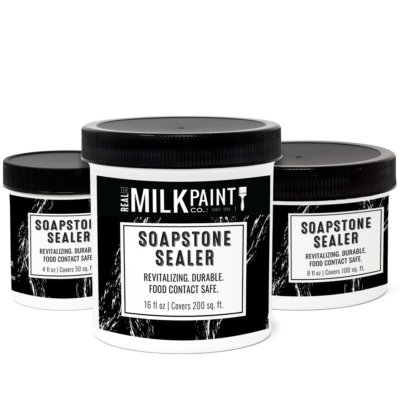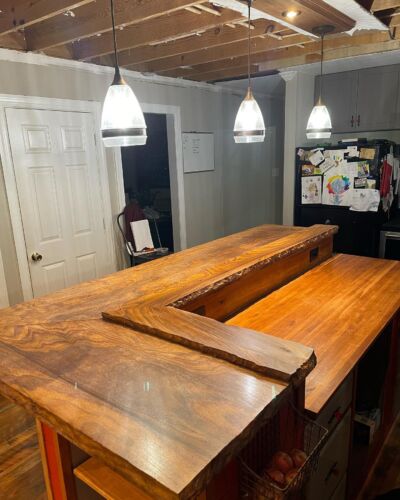What do you use to apply Real Milk Soapstone Sealer?
Keep it simple. Grab a soft, lint-free cloth (the inside of an old sock works surprisingly well) and get to work. No brushes, rollers or foam applicators, please.
How long does it take to dry?
Real Milk Soapstone Sealer dry to a hard finish in about 5 to 7 days, but a full cure can take anywhere from two weeks to a full month. Until you hit the initial one-week mark, it’s crucial that you keep the project surface free from water, soap and heavy objects to protect the final finish and let the oil-based sealer do its job.
Is Real Milk Soapstone Sealer and Wood Wax just for soapstone and wood?
 Nope! You might already know that you can use our soapstone sealer on soapstone sinks basins, soapstone countertops and wooden tabletops, but since it contains food-contact-safe material, it’s also great for cutting boards and wooden utensils. It can also be used on cast iron, concrete, tools and rusted metal. If you have a honed natural stone surface, a worn-out workshop table or an old wood stove that needs attention, this soapstone sealer could be the product you’ve been searching for.
Nope! You might already know that you can use our soapstone sealer on soapstone sinks basins, soapstone countertops and wooden tabletops, but since it contains food-contact-safe material, it’s also great for cutting boards and wooden utensils. It can also be used on cast iron, concrete, tools and rusted metal. If you have a honed natural stone surface, a worn-out workshop table or an old wood stove that needs attention, this soapstone sealer could be the product you’ve been searching for.
I can’t have nuts. Will I have an allergic reaction to the walnut oil in your sealer?
Although it cannot be completely ruled out, there is compelling evidence indicating that Soapstone Sealer, which contains walnut oil, is unlikely to trigger an allergic reaction. One reason is that walnut oil has a low protein content, which is often responsible for allergic responses. Additionally, walnut oil is a type of oil that polymerizes and dries. Allergens typically stem from oils that do not undergo this process. As walnut oil polymerizes and dries, its proteins become inactive.
The application of heat during the manufacturing of Soapstone Sealer accelerates the polymerization of walnut oil. This heating process (resulting in polymerized walnut oil) is believed to further minimize the risk of allergic reactions. That said, individual tolerance varies, and some people may be more sensitive than others, so we always recommend caution, especially if you’ve reacted to nut-based products in the past. We strongly advise customers with concerns about allergies to consult their physician before using Soapstone Sealer.
Can the sealer be applied too thickly?
Yes and no. It’s absolutely possible to apply an overly thick coat of sealer, but as long as you wipe off the excess sealer within 30 minutes, you won’t need to take extra steps such as using mineral spirits or Citrus Solvent to strip off the extra layer.
How often does Real Milk Paint Soapstone Sealer and Wood Wax need to be reapplied?
Reapply soapstone sealer whenever the finish seems to be wearing down or if you see a low-luster finish that needs a retouch. In short, reapply only as needed.
How do I prep the surface before applying? Can the sealer be applied over a previously mineral oiled surface?
 Mineral oil and walnut oil don’t mix, so we recommend using hot water and soap, mineral spirits, or our Citrus Solvent to remove mineral oil before applying our soapstone sealer. The same strippers can be used to prep the surface of your project piece to remove any other waxes or oils that might prevent the sealer from working properly. Removing drying oils and other waxes from the surface is also necessary before starting to apply soapstone sealer.
Mineral oil and walnut oil don’t mix, so we recommend using hot water and soap, mineral spirits, or our Citrus Solvent to remove mineral oil before applying our soapstone sealer. The same strippers can be used to prep the surface of your project piece to remove any other waxes or oils that might prevent the sealer from working properly. Removing drying oils and other waxes from the surface is also necessary before starting to apply soapstone sealer.
How do I clean a surface that’s been sealed?
Stick with mildsoap and water. Walnut oil takes just a few wipes of a soft cloth to clean. Harsh cleaners and acid-based products could eat away at the finish over repeated use.
How do I store my Real Milk Paint Soapstone Sealer and Wood Wax?
Avoid extreme cold or heat and don’t let the sealer sit overnight with its lid open. We recommend keeping the product in its original packaging and storing it in the fridge. Follow those suggestions and your container could last for years.



